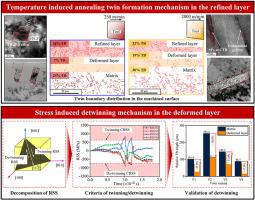International Journal of Machine Tools and Manufacture ( IF 14.0 ) Pub Date : 2023-09-08 , DOI: 10.1016/j.ijmachtools.2023.104074 Baochen Li , Hongguang Liu , Jun Zhang , Binbin Xu , Wanhua Zhao

|
Microstructural features are an important factor in the evaluation of machined surface integrity. In particular, twins and twin boundaries have a significant impact on the physical and mechanical properties of components. This study investigates twin boundary evolution mechanisms in the machined surface during orthogonal cutting of oxygen-free-high-conductivity copper with cutting speeds ranging from 125 m/min to 2000 m/min. Pertinent features including twin boundaries, grain morphologies, textures, etc. Are characterized by electron backscattered diffraction and transmission electron microscope. The results show that the machined surface is divided into the refined layer, the deformed layer, and the matrix. An abnormal gradient distribution of a 60°<111> twin boundary is discovered for the first time. Specifically, the annealing twins mostly diminish in the deformed layer and regenerate in the refined layer. In the refined layer, a temperature-dominated process of twin formation and dynamic recrystallization occur. In the deformed layer, the resolved shear stress along the twin system is calculated through a novel approach, which reveals the stress-induced detwinning mechanism. The results of this research are beneficial for understanding both the deformation mechanism of medium stacking fault energy face-centered cubic metal under extreme loading conditions and the underlying effects of twins on the mechanical properties of machined surface.
中文翻译:

随着切削速度的增加,热机械载荷引起的加工表面基于多机制的孪生演化
微观结构特征是评估加工表面完整性的重要因素。特别是,孪晶和孪晶边界对部件的物理和机械性能具有显着影响。本研究研究了无氧高导铜正交切削过程中加工表面的孪晶边界演化机制,切削速度范围为 125 m/min 至 2000 m/min。相关特征包括孪晶界、晶粒形态、纹理等。通过电子背散射来表征衍射和透射电子显微镜。结果表明,加工表面分为细化层、变形层和基体层。首次发现60°<111>孪晶边界的异常梯度分布。具体来说,退火孪晶主要在变形层中减少,并在细化层中再生。在精炼层中,发生孪晶形成和动态再结晶的温度主导过程。在变形层中,通过一种新方法计算沿孪晶系统的解析剪切应力该研究结果有利于理解介质的变形机制极端载荷条件下面心立方金属的堆垛层错能以及孪晶对加工表面机械性能的潜在影响。































 京公网安备 11010802027423号
京公网安备 11010802027423号